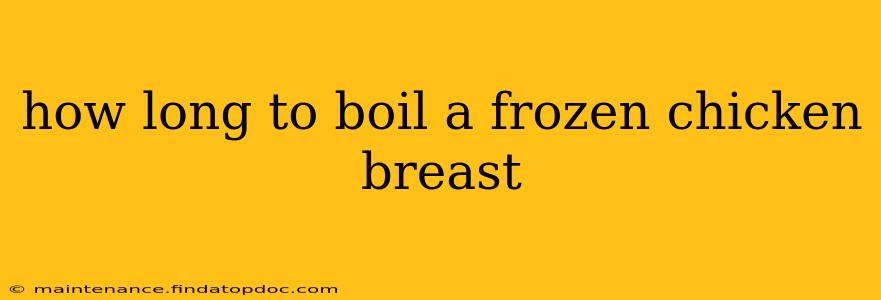Boiling frozen chicken breast might seem like a shortcut, but it's crucial to do it safely and effectively to ensure both tenderness and food safety. This guide will walk you through the process, addressing common concerns and providing tips for perfect results every time.
Why Boil Frozen Chicken Breast?
Boiling is a quick and efficient cooking method, particularly useful when you're short on time. It's also a healthy option as it requires minimal added fat. Boiling frozen chicken breast directly saves you the prep time of thawing it beforehand. However, it's essential to understand the implications of this method and adjust your cooking time accordingly.
How Long Does it Take to Boil a Frozen Chicken Breast?
The cooking time for a frozen chicken breast depends on its size and thickness. A general guideline is to allow at least 30-45 minutes for a medium-sized breast (around 6-8 ounces). However, it's crucial to ensure the internal temperature reaches a safe 165°F (74°C) throughout the entire breast. Using a meat thermometer is paramount to guarantee safety and prevent undercooking.
Larger breasts will require longer cooking times, potentially up to an hour or more. Smaller breasts might cook faster, but it's better to err on the side of caution and slightly overcook than risk undercooking.
What Happens if I Boil it for Too Long?
Overboiling can result in dry, tough, and stringy chicken breast. The longer the chicken boils, the more moisture it loses. While it's important to reach the safe internal temperature, aim to cook it just until done.
What Happens if I Don't Boil it Long Enough?
Undercooked chicken poses a significant health risk due to potential bacterial contamination. Never consume chicken that hasn't reached a safe internal temperature of 165°F (74°C). Using a meat thermometer is the only reliable way to determine doneness.
How to Boil a Frozen Chicken Breast Safely and Effectively
- Start with Plenty of Water: Use enough water to completely submerge the frozen chicken breast.
- Bring Water to a Rolling Boil: This ensures even heat distribution and faster cooking.
- Add the Frozen Breast: Gently lower the frozen chicken breast into the boiling water.
- Reduce Heat to a Simmer: Once the water returns to a boil after adding the chicken, reduce the heat to maintain a gentle simmer. This prevents vigorous bubbling that could tear the chicken.
- Monitor the Temperature: Regularly check the internal temperature of the chicken using a meat thermometer inserted into the thickest part. Do not rely solely on visual cues; the chicken may appear cooked on the outside while still being frozen inside.
- Continue Simmering Until 165°F (74°C): Once the internal temperature reaches 165°F (74°C), remove the chicken from the water.
- Let it Rest: Allow the chicken to rest for a few minutes before shredding or slicing. This allows the juices to redistribute, resulting in a more tender and flavorful final product.
Tips for Boiling Frozen Chicken Breast
- Use a Large Pot: A large pot provides enough space for the chicken to cook evenly and prevents overcrowding.
- Season the Water: Add herbs, spices, or bouillon cubes to the water to infuse flavor into the chicken.
- Don't Overcrowd the Pot: Overcrowding will lower the water temperature and increase cooking time. Cook several breasts in batches if necessary.
Can I Boil Frozen Chicken Breast for Soup or Stock?
Absolutely! Boiling frozen chicken breast is an excellent way to prepare chicken for soup or stock. The long cooking time helps to extract maximum flavor from the chicken. Simply follow the instructions above, and then shred the cooked chicken and add it to your soup or stock recipe.
This detailed guide ensures you can safely and efficiently boil your frozen chicken breast, leading to a delicious and healthy meal. Remember that food safety is paramount; always use a meat thermometer to ensure the chicken reaches the safe internal temperature.
